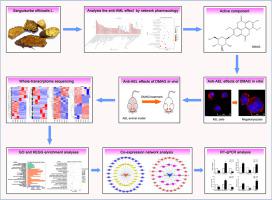Pharmacological Research ( IF 9.1 ) Pub Date : 2021-02-12 , DOI: 10.1016/j.phrs.2021.105491 Wang Long 1 , Sha Liu 2 , Xiao-Xuan Li 3 , Xin Shen 4 , Jing Zeng 1 , Jie-Si Luo 1 , Ke-Ru Li 2 , An-Guo Wu 5 , Lu Yu 2 , Da-Lian Qin 5 , Guang-Qiang Hu 2 , Jing Yang 1 , Jian-Ming Wu 5

|
Acute erythroid leukemia (AEL) is a rare and aggressive hematologic malignancy with no specific treatment. Sanguisorba officinalis L. (S. officinalis), a well-known traditional Chinese medicine, possesses potent anticancer activity. However, the active components of S. officinalis against AEL and the associated molecular mechanisms remain unknown. In this study, we predicted the anti-AML effect of S. officinalis based on network pharmacology. Through the identification of active components of S. officinalis, we found that 3,8-Di-O-methylellagic acid 2-O-glucoside (DMAG) not only significantly inhibited the proliferation of erythroleukemic cell line HEL, but also induced their differentiation to megakaryocytes. Furthermore, we demonstrated that DMAG could prolong the survival of AEL mice model. Whole-transcriptome sequencing was performed to elucidate the underlying molecular mechanisms associated with anti-AEL effect of DMAG. The results showed that the total of 68 miRNAs, 595 lncRNAs, 4030 mRNAs and 35 circRNAs were significantly differentially expressed during DMAG induced proliferation inhibition and differentiation of HEL cells. Gene Ontology (GO) and Kyoto Encyclopedia of Genes and Genomes (KEGG) pathway analyses revealed that the differentially expressed miRNAs, lncRNAs, mRNAs and circRNAs were mainly involved in metabolic, HIF-1, MAPK, Notch pathway and apoptosis. The co-expression networks showed that miR-23a-5p, miR-92a-1–5p, miR-146b and miR-760 regulatory networks were crucial for megakaryocyte differentiation induced by DMAG. In conclusion, our results suggest that DMAG, derived from S. officinalis might be a potent differentiation inducer of AEL cells and provide important information on the underlying mechanisms associated with its anti-AEL activity.
中文翻译:

全转录组测序和综合网络分析阐明了红白血病细胞新型分化诱导剂 Sanguisorba offcinalis L. 衍生的 3,8-Di-O-methylellagic acid 2-O-glucoside 的作用
急性红细胞白血病 (AEL) 是一种罕见的侵袭性血液系统恶性肿瘤,没有特定的治疗方法。Sanguisorba officinalis L. ( S. officinalis ) 是著名的中药,具有很强的抗癌活性。然而,S. officinalis对抗 AEL的活性成分和相关的分子机制仍然未知。在这项研究中,我们基于网络药理学预测了S. officinalis的抗 AML 作用。通过鉴定S. officinalis的活性成分,我们发现3,8-二-O-甲基鞣花酸2-O-葡萄糖苷(DMAG)不仅能显着抑制红白血病细胞系HEL的增殖,还能诱导其向巨核细胞分化。此外,我们证明 DMAG 可以延长 AEL 小鼠模型的存活时间。进行全转录组测序以阐明与 DMAG 的抗 AEL 作用相关的潜在分子机制。结果表明,在DMAG诱导的HEL细胞增殖抑制和分化过程中,共有68个miRNA、595个lncRNA、4030个mRNA和35个circRNA存在显着差异表达。基因本体论(GO)和京都基因与基因组百科全书(KEGG)通路分析表明,差异表达的miRNAs、lncRNAs、mRNAs和circRNAs主要参与代谢、HIF-1、MAPK、Notch通路与细胞凋亡。共表达网络显示 miR-23a-5p、miR-92a-1-5p、miR-146b 和 miR-760 调节网络对 DMAG 诱导的巨核细胞分化至关重要。总之,我们的结果表明 DMAG 源自S. officinalis可能是 AEL 细胞的有效分化诱导剂,并提供与其抗 AEL 活性相关的潜在机制的重要信息。









































 京公网安备 11010802027423号
京公网安备 11010802027423号